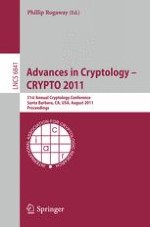This book constitutes the refereed proceedings of the 31st Annual International Cryptology Conference, CRYPTO 2011, held in Santa Barbara, CA, USA in August 2011. The 42 revised full papers presented were carefully reviewed and selected from 230 submissions. The volume also contains the abstract of one invited talk. The papers are organized in topical sections on randomness and its use; computer-assisted cryptographic proofs; outsourcing and delegatin computation; symmetric cryptanalysis and constructions; secure computation: leakage and side channels; quantum cryptography; lattices and knapsacks; public-key encryption; symmetric schemes; signatures; obilvious transfer and secret sharing; and multivariate and coding-based schemes.
